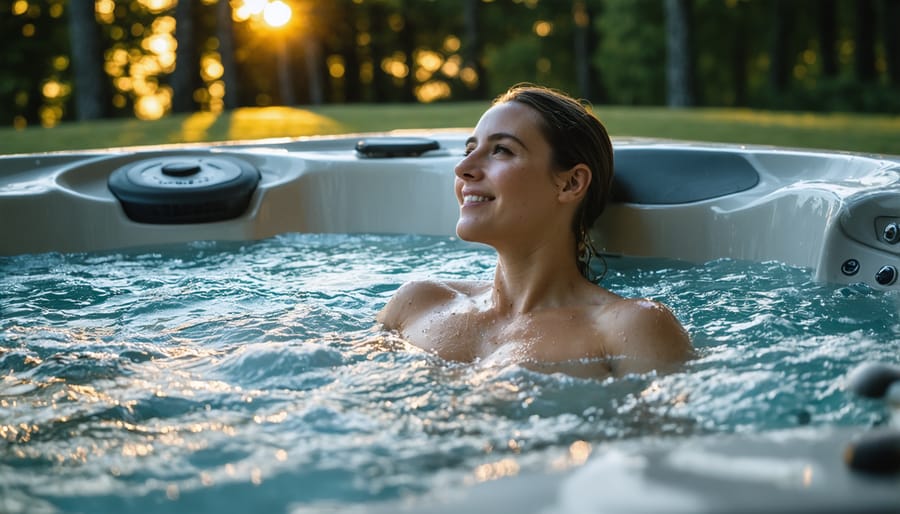Soaking in a hot tub does more than just melt away the day’s stress – it’s a powerful wellness tool backed by decades of scientific research. From easing chronic pain and improving sleep quality to lowering blood pressure and accelerating muscle recovery, hot tubs offer a unique combination of hydrotherapy, heat therapy, and massage that can transform your health routine. Modern studies show that regular hot tub sessions can reduce inflammation, increase flexibility, and even help manage conditions like arthritis and fibromyalgia. While luxury spas once seemed like an extravagant investment, more homeowners are now recognizing hot tubs as essential components of their wellness strategy, providing year-round access to therapeutic benefits right in their backyard. Whether you’re an athlete looking to enhance recovery, someone managing chronic pain, or simply seeking a natural way to unwind and improve your overall well-being, understanding the science-backed benefits of hot tub therapy can help you make an informed decision about this powerful health investment.
Physical Health Benefits of Hot Tub Therapy
Pain Relief and Muscle Recovery
When it comes to pain relief and muscle recovery, hot tubs offer some impressive therapeutic benefits of hydrotherapy that have made them a favorite among athletes and anyone dealing with chronic pain. The combination of heat, buoyancy, and massage jets creates the perfect environment for natural healing and relief.
The warm water increases blood flow throughout your body, helping to deliver oxygen and nutrients to sore muscles while flushing away metabolic waste products. This improved circulation can significantly reduce recovery time after intense workouts and help ease the discomfort of delayed onset muscle soreness (DOMS).
For those dealing with chronic conditions like arthritis or fibromyalgia, regular hot tub sessions can provide much-needed relief. The water’s buoyancy reduces pressure on joints by supporting up to 90% of your body weight, allowing for gentle movement without strain. Meanwhile, the strategically placed jets deliver targeted massage therapy to specific muscle groups, helping to release tension and break up painful knots.
Many physical therapists and sports medicine professionals recommend hot tub therapy as part of a recovery routine. A 15-20 minute soak after exercise or before bed can help reduce inflammation, ease muscle tension, and promote faster healing. The best part? Unlike many other recovery methods, relaxing in a hot tub is an enjoyable experience that you’ll actually look forward to incorporating into your wellness routine.

Better Sleep and Circulation
Looking for a natural way to improve your sleep quality and boost circulation? Your hot tub might be the perfect solution. Regular evening soaks can help prepare your body for a restful night’s sleep by naturally raising and then lowering your body temperature – a process that mimics your body’s natural sleep cycle.
When you immerse yourself in warm water, your blood vessels dilate, improving circulation throughout your body. This enhanced blood flow doesn’t just feel good; it helps deliver oxygen and nutrients more effectively to your muscles and organs. Many hot tub enthusiasts report falling asleep more quickly and enjoying deeper, more satisfying sleep after an evening soak.
The cardiovascular benefits are equally impressive. The combination of warm water and massage jets creates a gentle workout for your heart, as it works to cool your body and adjust to the water pressure. This can help strengthen your heart muscle over time, similar to light exercise, but with less strain on your joints.
For the best results, try soaking for 15-20 minutes about two hours before bedtime. This timing allows your body temperature to rise and then gradually cool down, naturally preparing you for sleep. Keep the water temperature between 98-102°F for optimal relaxation without overheating, and always stay hydrated during your soak.
Mental Health and Stress Relief

Stress Reduction and Relaxation
One of the most celebrated benefits of hot tub ownership is its remarkable ability to melt away stress and promote deep relaxation. The combination of warm water, massaging jets, and gentle buoyancy creates a perfect environment for mental unwinding. As you sink into the heated water, your body releases endorphins – natural mood elevators that help combat anxiety and depression.
Many hot tub enthusiasts report that a 20-minute soak before bedtime significantly improves their sleep quality and helps quiet racing thoughts. The gradual cooling of your body temperature after leaving the hot tub naturally signals your brain that it’s time to rest, making it easier to drift off to sleep.
The meditative aspect of hydrotherapy shouldn’t be overlooked either. The rhythmic sound of bubbling water and the sensation of weightlessness can create a mindful moment in your day, offering a much-needed break from the constant connectivity of modern life. Whether you’re seeking a peaceful morning ritual or a calming evening routine, regular hot tub sessions can become an essential part of your stress management toolkit, helping you maintain better emotional balance and mental clarity.
Social and Relationship Benefits
Hot tubs offer a unique space for meaningful social connections and family bonding that’s hard to replicate elsewhere. When you create a relaxing backyard oasis, you’re building more than just a water feature – you’re crafting a gathering spot where conversations flow naturally and relationships deepen.
Families with busy schedules often struggle to find quality time together, but a hot tub provides a natural meeting point free from phones and other distractions. Whether it’s catching up with teenagers about their day or enjoying a romantic evening with your partner, the warm, bubbling water creates an intimate atmosphere that encourages open communication.
Hot tubs also make entertaining more memorable. Hosting friends for a casual soak can transform an ordinary get-together into a spa-like experience. The relaxed environment helps break down social barriers, leading to more authentic conversations and stronger friendships. Even in cooler months, your hot tub can become the centerpiece of outdoor gatherings, extending your social season year-round.

Safety and Best Practices
Temperature and Time Guidelines
To get the most out of your hot tub experience, it’s essential to maintain the right temperature and timing. The ideal hot tub temperature typically ranges between 100-104°F (37.8-40°C), with 102°F (38.9°C) being the sweet spot for most users. However, if you’re new to hot tubbing, start at a lower temperature around 100°F and gradually work your way up to find your comfort zone.
When it comes to soaking duration, the magic number is typically 15-30 minutes. This timeframe allows you to reap the therapeutic benefits without risking overheating or dehydration. Keep in mind that on warmer days, you might want to reduce your soaking time or lower the temperature slightly.
For those using the hot tub before bedtime, consider setting the temperature slightly lower, around 98-100°F, and limit your soak to 20 minutes. This helps promote relaxation without overheating your body before sleep. During winter months, you might prefer higher temperatures, but never exceed 104°F, as this can be dangerous.
Special considerations apply for certain groups: pregnant women should limit temperature to 100°F and soaking time to 10 minutes, while those with heart conditions or high blood pressure should consult their healthcare provider for personalized guidelines. Always keep a water bottle nearby and exit the tub if you feel lightheaded or uncomfortable.
Maintenance for Health Benefits
Just like maintaining your home, keeping your hot tub in top condition is essential for reaping its full health benefits. Regular maintenance isn’t just about aesthetics – it’s about creating a safe, therapeutic environment that can truly enhance your wellbeing.
Start with proper water sanitization to ensure your hot tub remains free from harmful bacteria and contaminants. Think of it as creating a clean sanctuary for your relaxation and healing sessions. Check chemical levels at least twice a week and adjust as needed to maintain the perfect balance.
Don’t forget about the filters – they’re like your hot tub’s kidneys! Clean them monthly and replace them according to manufacturer recommendations. A clean filter means cleaner water, which translates to better skin health and a more hygienic soaking experience.
Regular water changes every 3-4 months help prevent biofilm buildup and ensure the water remains fresh and rejuvenating. Keep the cover clean and properly fitted to maintain water temperature and prevent debris from entering – this not only saves energy but also preserves water quality.
Remember to inspect jets and other components periodically. Properly functioning jets deliver the targeted hydrotherapy that helps soothe muscles and improve circulation. By maintaining these elements, you’re not just preserving your investment – you’re safeguarding your path to better health and wellness.
Hot tubs offer an impressive array of health benefits that make them more than just a luxurious addition to your home. From soothing sore muscles and improving sleep quality to reducing stress and anxiety, regular hot tub use can significantly enhance your overall well-being. The combination of warm water therapy, massage jets, and buoyancy creates a perfect environment for both physical recovery and mental relaxation.
When used properly and consistently, hot tubs can become an integral part of your wellness routine. The heat therapy helps increase blood circulation, reducing inflammation and promoting faster healing of minor injuries. The weightless environment provides relief for arthritis sufferers and those with joint pain, while the massaging action of the jets helps release tension in tight muscles.
Beyond the physical benefits, the mental health advantages are equally compelling. Taking time to unwind in your hot tub can lower cortisol levels, improve mood, and provide a much-needed escape from daily stresses. It’s also an excellent way to practice mindfulness and create a peaceful evening routine that promotes better sleep.
To maximize these benefits, aim to use your hot tub 2-3 times per week for 15-20 minutes per session. Always follow proper safety guidelines, maintain appropriate water temperature and chemical balance, and listen to your body’s signals. While hot tubs are generally safe for most people, consulting with your healthcare provider before starting regular sessions is recommended, especially if you have underlying health conditions.
By incorporating hot tub therapy into your lifestyle, you’re investing in both your physical health and emotional well-being. It’s a natural, enjoyable way to enhance your quality of life while creating a spa-like retreat in your own backyard.








